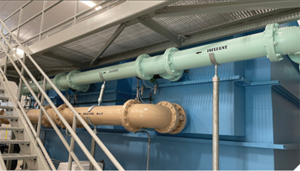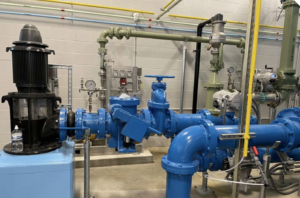Plan Now to Secure Funding for Water Infrastructure Upgrades and Replacement
By Deborah Lynn Blumberg
In South Haven, the issue of aging infrastructure had come to a head, impacting water quality for its 189 residents.
The city needed updates like a new water main and equipment for its water treatment plant. But an obstacle stood in the way of repairs. “We didn’t have money just sitting around to put toward the project,” said Melissa Stenson, South Haven city clerk.

South Haven is far from alone. Funding aging infrastructure repairs is a major problem in the U.S., with some $625 billion over the next 20 years needed just for drinking water pipe replacement, treatment plant upgrades, storage tanks, and other key assets, according to the Environmental Protection Agency’s (EPA) 7th Drinking Water Infrastructure Needs Survey and Assessment. Minnesota will need around $7 billion to fund its drinking water system improvements and over $4 billion for wastewater and stormwater fixes.
In addition to crumbling infrastructure, cities also face increasing regulations around water contaminants like PFAS, or per- and polyfluoroalkyl substances, so-called forever chemicals found in products like carpets, clothing, and cosmetics. According to the Minnesota Department of Health, 22 Minnesota water systems have PFAS above new federal limits.
“Communities are having to put in new facilities that can handle the treatment of emerging contaminates,” said Lori Blair, executive director of the Minnesota Rural Water Association.
The EPA’s proposed rule to accelerate the move away from lead pipes would also require most water systems in the U.S. to replace lead service lines within 10 years. For now, communities have until Oct. 16, 2024, to submit an inventory of service line materials to the state. “Getting rid of lead service lines is a big project,” Blair said.
Replacing aging infrastructure
The good news is that there is funding to help Minnesota cities finance these critical large-scale projects.
In South Haven, Stenson secured a mix of bonding dollars, a short-term loan, and grants to fund its projects. The engineering firm the city works with was essential in alerting her to opportunities and in helping the city apply.

South Haven received $3.5 million from the state bonding bill after Stenson testified before the Minnesota House and Senate about the city’s needs. Other pieces of funding came in the form of a $600,000 grant from the Small Cities Development Program for a new water tower and a $584,303 Local Road Improvement Program or LRIP grant to make roads and sidewalks Americans with Disabilities Act (ADA) compliant after they were torn up as part of the updates. The city also received a $6,832 grant from Wright County for improving the stormwater infrastructure.
“We got really lucky with our grants,” Stenson said. “The most important thing is to work with your engineering firm and have them help you find the funding.”
One of the first places for cities to look for funding help is the Minnesota Public Facilities Authority (PFA). It plays a major role in funding distribution, whether it’s through grants or low-interest loans.
“We fund most types of basic municipal wastewater and drinking water infrastructure projects,” said PFA Executive Director Jeff Freeman.
Most PFA-funded projects involve replacement of aging infrastructure, aging pipes or treatment plants, and improvements for better service and efficiency, he adds. Upgrades to meet more stringent treatment requirements also fall within funding eligibilities purview, he said, though sewer extensions for new development do not.
The first step for cities looking for infrastructure funding assistance from PFA is to submit a project proposal to either the Minnesota Pollution Control Agency for wastewater projects, or the Minnesota Department of Health for drinking water system projects. Projects are then ranked on a priority list. Rankings are driven by how critical the projects are deemed to public health and water quality.
“It’s key where a project ranks on that list because it determines if it’s likely that PFA will be able to fund a project or not,” Freeman said. “We can’t fund everything. There’s more demand than we have funding capacity.”
Typically, PFA is able to offer lowinterest loans to the majority of projects on the priority list. PFA extends around $200 million a year in low-interest loans. Currently, rates are between 1% to 2%, significantly better than rates available in the private bond market. “There’s a lot of interest savings there,” Freeman said.
Applying for PFA grants
Grants are harder to get. PFA has two grant programs, each with a distinct purpose. The Water Infrastructure Fund, or WIF grants, are based on affordability needs.
“With every applicant, we start by looking at the costs to cover basic operation and maintenance of the system and ensuring the city is generating sufficient revenues within their enterprise fund and user base to cover those expenses.” Freeman said.
Then, PFA looks at how much the city can put toward debt service on a new project. WIF grants typically go to smaller communities, he said, because they often lack the user base to share the costs to affordably complete the infrastructure projects they need.
Cities are asked to provide an analysis of their water or sewer rates and revenues to determine their ability to make annual debt service payments and their potential eligibility for WIF grants. An engineer or a financial adviser can help complete this type of rate analysis, which the PFA can then review.
The second type of grants are Point Source Implementation Grants. These are designed to help cities upgrade their wastewater treatment plants to improve water quality by meeting more stringent limits for the discharge of pollutants like phosphorus discharges, said Freeman.
PFA’s intended use plan
Once cities have their infrastructure project scheduled for construction, the next step is to get placed on PFA’s annual intended use plan. It has one plan for wastewater projects and another for drinking water. The intended use plan identifies projects on the project priority list that are eligible each year to apply for PFA loans and grants.
“It’s an annual process,” said Freeman. “Once you’re on the intended use plan in fundable range, your project is typically ready for funding in the next one to two years.”
For 2024, 101 projects in the fundable range based on the priority list are on PFA’s clean water intended use plan, representing total requested low-interest loans of over $500 million. Its drinking water intended use plan for 2024 has 156 projects for $600 million. “The overall message is that low-interest loans are widely available for most projects and cities of all sizes throughout the state,” he said.
Lead service line replacements represent a new category of projects on PFA’s drinking water intended use plan, and there’s a separate list of those requests, which all rank very high on the priority list, Freeman said. The federal Infrastructure Investment and Jobs Act appropriated a large amount of federal funding to replace lead service lines, and last year, the Minnesota Legislature appropriated $240 million for lead service line replacement, and set a goal of 2033 to replace all lead service lines.
PFA’s program combines the federal and state funding. “With the combination of federal and state funding, we expect to be able to replace all of the lead service lines at no cost to homeowners or cities,” Freeman said.
The first set of lead-related projects on the current intended use plan — 64 projects for a total of $102 million between public and private costs — began in spring and summer 2024.
Funding for rural communities
Blair said the need for state and federal funding is especially critical for rural communities with smaller populations. “There’s a big burden on smaller, and often distressed and disadvantaged communities, because the cost of building a treatment plant is the same for a smaller community as larger ones with more resources,” she said.
Rural communities have additional resources available to them, Blair said. The U.S. Department of Agriculture’s (USDA) Water and Environmental Programs, or WEP, offer loan and grant funding to rural areas at favorable rates.
For example, officials in the City of Bagley, population 1,300, secured $12 million in financing through USDA Rural Development for the city’s recent water and sewer project, Blair said. Infrastructure grant money is also sometimes available through the Small Cities Development Program, adds Blair. South Haven received one of those grants.
The Minnesota Rural Water Association offers in-person financing information sessions several times a year, Blair said, during which agency representatives and consultants explain various funding options.
On Nov. 13, 2024, it will hold a one-day “financing your community project” training in St. Cloud.
A critical step: A capital improvement plan
Josh Stier, principal engineer at Bolton & Menk, which provides public infrastructure planning and approaches, said the communities his firm works with on their water infrastructure may seek help for a sewer back-up or water quality issue, but often addressing the initial problem exposes a larger systemic need.
“Usually, the community hasn’t moved the needle in a long time if their infrastructure is failing,” he said. Stier’s first step is to work with communities to develop or fine-tune a capital improvement plan.
“Staff know their communities better than anyone,” he said. “One of the first questions I ask is, ‘when you lay in bed at night worrying about your system, what’s something you lose sleep over?’ That really opens the door to a more in-depth conversation.”
While some communities may balk at the upfront cost of putting together a capital improvement plan, it will pay off in the long run, Stier said. It’s an important exercise because the plan prioritizes needs and creates a strategic approach based on engineering to improve systems. It includes cost estimates and a timeline.
“Most bigger communities do have a plan,” he said, “but for smaller ones, it’s very rare to have a current plan. It’s important to take a holistic approach to get the most return on their investment, and this helps.”
Most communities can’t write a check for a million dollars, he adds, so careful planning for funding is critical. For cities that work with a financial adviser, Stier will share the capital improvement plan with them, then work hand-in-hand on the finances.
“There is a lot of funding out there,” Stier said. “But funding is more competitive than it’s ever been because the need has never been higher.” Gone, he said, are the days when a need is enough to get funding.
“Planning has become a vital part of the process,” he said. “And the stronger your plan, the more your need shows, and then the better your chance at getting funding.” The bottom line is that doing your homework up front makes it easier to get funding on the back-end, said Stier.
When applying for grants, in particular, be aggressive, Stier said, and don’t be dissuaded by a failed application. With the current level of competition, rejection is bound to happen. Learn from it, he said.
“Ask how you can improve your grant application. Most of the time, administrators are open to talking about how to make an application better.”
Freeman said a critical takeaway is that communities must constantly plan for the future when it comes to infrastructure finance. “We really want cities to be planning ahead and doing asset management plans for their systems, so they recognize the useful life for all the components of their system and have a specific schedule for when things need to be replaced and improved,” he said. “The funding programs are there to help, but the process takes time and it’s important for cities to plan ahead.”
With cities’ central role in providing safe drinking water to residents and preserving critical natural resources like lakes, rivers, and wetlands, this type of proactive planning, solid partnerships, and thoughtful approaches to infrastructure projects will help to benefit future generations.
Deborah Lynn Blumberg is a freelance writer.

